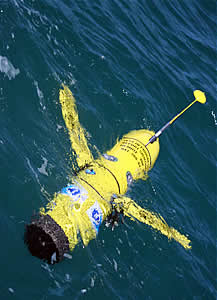
Mote scientists spent Thursday using side-scan sonar in an effort to find a scientific robot that has been missing since Monday, Aug. 31, 2009. Now we're seeking the public's help for the safe return of the robot nicknamed "Waldo." (Yes, after that Waldo!)
The robot - an autonomous underwater vehicle or AUV for short - had been patrolling the waters off Southwest Florida for five days looking for signs of red tide. The robot is equipped with a BreveBusterTM, a device designed and built by Mote scientist Dr. Gary Kirkpatrick that can automatically detect the presence of red tide in the water.
The AUVs are designed to glide up and down and forward through the water, sending signals to satellites each time they surface. Waldo was tooling along offshore from Venice just fine, making reports every two hours between Aug. 26 and 31.
"Then, bam, it just stopped sending a signal," Kirkpatrick said. "There are a few possibilities that we think are likely: It could have had a major leak or malfunction and sank to the bottom and is just sitting there. Or, it could have had a malfunction with its computer or its communication system and is floating on the surface but unable to tell us that it's there."
An unsuspecting boater who didn't realize the device was a scientific instrument may have also taken the BreveBuster.TM "We're hoping that if anyone has seen Waldo, they will call and let us know so we can pick it up," Kirkpatrick said.
Mote is offering a $500 "No-Questions-Asked" reward for the return of Waldo. Scientists are hoping that with Labor Day being a busy boating holiday, someone will spot the AUV and help us bring it home. Anyone with information about Mote's missing AUV is asked to call (941) 388-4441 x 271.
While given a tongue-in-cheek nickname, Waldo has a pretty serious job doing red tide patrols. The information the BreveBusterTM-packed AUV transmits back to researchers in the lab is important to help us unlock how red tides begin, where they travel and what eventually causes a bloom's demise. Since it's too expensive to send researchers out on boats to patrol for red tide 24 hours a day, seven days a week, the job has been turned over to robots like Waldo.
Waldo - along with two other AUVs nicknamed Carmen and Nemo - has been "on the job" for Mote since 2005, through a grant from Florida's Fish and Wildlife Conservation Commission (FWC). Nemo and Carmen joined the fleet in 2006 through a grant from the National Oceanic and Atmospheric Administration (NOAA). Each AUV costs about $100,000, plus another $30,000 to equip it with a red tide detector. Not only are the instruments costly, finding Waldo is also important so we can understand what happened if the instrument malfunctioned, Kirkpatrick said.
Using the AUVs and BreveBusters has helped show that phytoplankton, the group of microscopic organisms that the red tide belongs to, are very unevenly distributed in the waters off the coast of Southwest Florida. This information would not have been gathered without the continuous observations supplied by the AUVs. Kirkpatrick points out that, "there are some types of information about the ocean that are only accessible through the use of robots."
